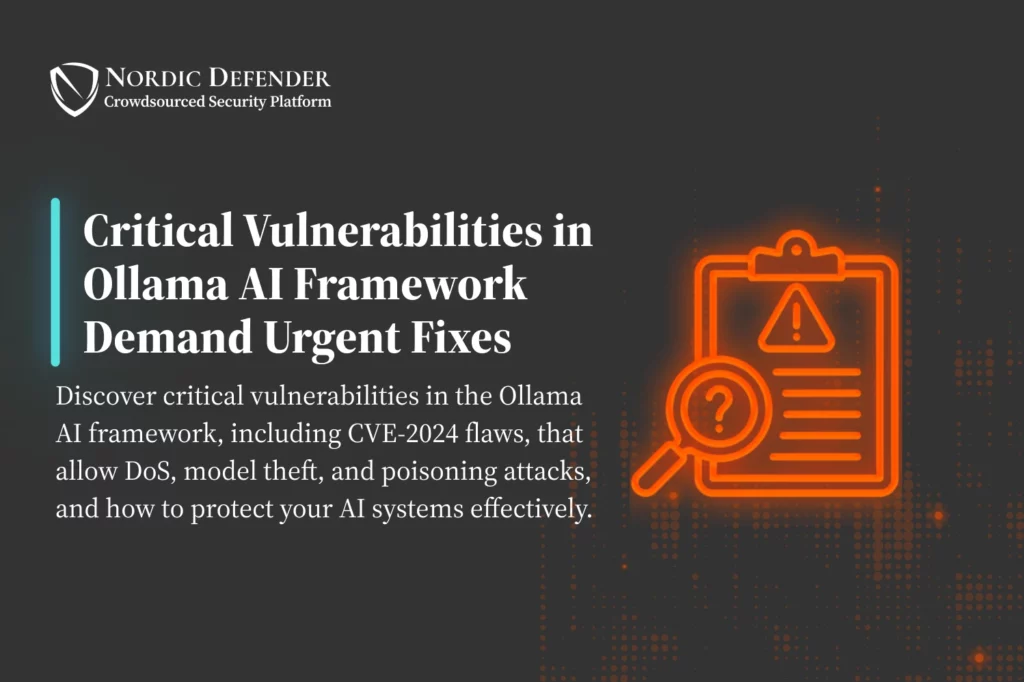The rapid evolution of AI technology highlights the importance of cybersecurity in deploying machine learning models across industries. Recently, critical vulnerabilities were identified in the Ollama AI framework, a widely used open-source platform for running large language models (LLMs) on Windows, Linux, and macOS devices. Here’s an overview of these vulnerabilities, the potential threats they pose, and the necessary steps to protect AI systems effectively.
Overview of the Vulnerabilities
Researchers discovered six major vulnerabilities within Ollama’s framework, which could enable malicious actors to exploit the system for various attacks, including denial-of-service (DoS), model theft, and model poisoning. These vulnerabilities are classified by Common Vulnerabilities and Exposures (CVE) identifiers, with Common Vulnerability Scoring System (CVSS) scores ranging up to 8.2, making them serious threats in the context of sensitive data and model integrity. Below are the identified vulnerabilities:
CVE-2024-39719 (CVSS 7.5)
An endpoint vulnerability at /api/create can be used to determine file existence on the server, potentially exposing sensitive information. (Fixed in version 0.1.47)
CVE-2024-39720 (CVSS 8.2)
An out-of-bounds read vulnerability that could cause crashes, allowing a DoS attack. (Fixed in version 0.1.46)
CVE-2024-39721 (CVSS 7.5)
Excessive resource exhaustion can trigger a DoS when /dev/random is used as input repeatedly in the /api/create endpoint. (Fixed in version 0.1.34)
CVE-2024-39722 (CVSS 7.5)
A path traversal vulnerability within the /api/push endpoint exposes the directory structure and files. (Fixed in version 0.1.46)
Two additional vulnerabilities, linked to model poisoning through /api/pull and model theft via /api/push, remain unpatched. These could enable attackers to corrupt or steal AI models, affecting both performance and intellectual property.
The Risks of These Vulnerabilities
Given the widespread use of Ollama, successful exploitation of these vulnerabilities could disrupt a range of industries, including finance, healthcare, and logistics. Potential consequences include:
- Denial of Service (DoS): Malicious actors could overwhelm the system, leading to critical AI applications going offline, which could impact time-sensitive operations and lead to financial and reputational harm.
- Model Theft: AI models represent significant intellectual property, and exposure to these vulnerabilities could lead to competitors or bad actors stealing or altering proprietary algorithms.
- Model Poisoning: Attackers can inject harmful data, altering model predictions and decisions. This may severely impact operational integrity, causing AI applications to produce misleading or inaccurate results.
- Mitigating Risks: Practical Steps for AI Security
While some vulnerabilities have been addressed, several remain unresolved, underscoring the need for a proactive approach to AI security. Key protective measures include:
- Restrict Access to Model Endpoints: Strict access control for model endpoints can prevent unauthorized actors from targeting exposed points. Using firewalls and proxies is essential in protecting these areas.
- Deploy Intrusion Detection Systems (IDS): AI-compatible IDS tools help detect unusual activity or access patterns, providing early warning signs of potential attacks.
- Conduct Routine Vulnerability Assessments: AI frameworks should undergo regular security assessments to identify and resolve vulnerabilities before exploitation occurs.
- Data Sanitization and Model Validation: Implementing data checks and validating model performance help prevent data poisoning and maintain model accuracy over time.
The Path Forward for AI Security
AI adoption will only continue to grow, making these threats more relevant and urgent. Companies across all sectors need to take stock of their AI frameworks and ensure they’re implementing state-of-the-art cybersecurity measures to address these evolving risks. Engaging with security providers who specialize in AI-specific threats can be an invaluable step toward securing sensitive models and data.
For companies relying on frameworks like Ollama, vigilance is key. Security leaders should prioritize ongoing education and awareness within their teams, focusing on the unique risks that AI models and frameworks bring to the table.
